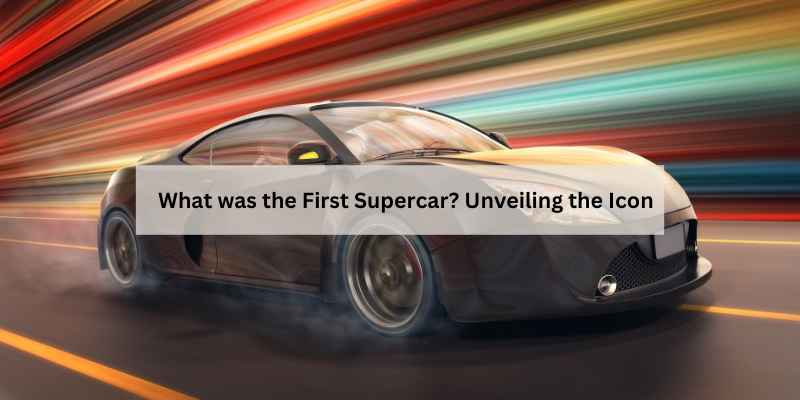What was the First Supercar? Unveiling the Icon
The first supercar is widely regarded as the Lamborghini Miura, introduced in 1966. Its groundbreaking design and performance set new standards for high-performance vehicles.
The term “supercar” defines a class of high-performance sports cars that push the boundaries of speed and design. The Lamborghini Miura emerged during a transformative era in automotive history, showcasing innovative engineering and breathtaking aesthetics. This iconic car featured a mid-engine layout, which improved handling and performance.
The Miura quickly captured the attention of enthusiasts and collectors alike, establishing itself as a symbol of luxury and power. As supercars evolved, the Miura laid the foundation for future models, influencing design and engineering for decades. Understanding its impact helps appreciate the evolution of high-performance automobiles today.
The Quest For Speed: Birth Of The Supercar Concept
The first supercar was a game changer in the automotive world. Early innovations helped shape its design and performance. Cars began to focus on speed, style, and power.
Many racing enthusiasts wanted faster cars. They pushed manufacturers to create more advanced models. This led to iconic designs that captured public attention. Public fascination grew as these cars raced on tracks.
Famous models like the Ferrari 250 GTO and Lamborghini Miura emerged from this era. These cars had sleek lines and powerful engines. They set new standards for what a supercar should be.
Defining The Supercar: Performance Meets Luxury
Supercars combine high performance with luxury features. These cars are built for speed and style. They often have powerful engines and advanced technology. The design is sleek and attractive, catching everyone’s eye.
Key characteristics include:
- Speed: Supercars can reach very high speeds quickly.
- Handling: Excellent control on curves and straight roads.
- Luxury: High-quality materials and comfortable interiors.
- Exclusivity: Often produced in limited numbers.
The evolution of supercars shows a blend of innovation and tradition. Early models laid the foundation for today’s designs. Each new model pushes the limits of what is possible.
The Contenders For The First Supercar Title
The title of the first supercar is often debated. Several legendary models are strong contenders. Each has unique features and historical significance.
Historical milestones in supercar development include key innovations. The 1960s saw the rise of powerful engines and aerodynamic designs. These changes set the stage for modern supercars.
| Model | Year | Top Speed (mph) |
|---|---|---|
| Lamborghini Miura | 1966 | 170 |
| Ferrari F40 | 1987 | 201 |
| Porsche 959 | 1986 | 197 |
These models showcase the evolution of speed and style. Each contributed to the supercar legacy we admire today.
Lamborghini Miura: The Pinnacle Of 60s Innovation
The Lamborghini Miura changed the world of supercars in the 1960s. Its sleek design and powerful engine set new standards. The Miura featured a mid-engine layout. This design improved handling and performance. It had a V12 engine that produced 350 horsepower. This made it one of the fastest cars of its time.
The style of the Miura was revolutionary. Smooth lines and a low profile made it look aggressive. It caught the attention of car lovers everywhere. Many car makers followed its design. The Miura inspired future supercars like the Ferrari and McLaren.
Its legacy remains strong today. The Miura is often called the first supercar. It paved the way for innovation in the auto industry.
Mercedes-benz 300sl ‘gullwing’: A Trailblazer
The Mercedes-Benz 300SL ‘Gullwing’ was a true trailblazer in the automotive world. It featured unique gullwing doors that set it apart from other cars. This design not only looked stunning but also served a practical purpose. The car had a powerful 3.0-liter inline-six engine that produced 215 horsepower. It could reach speeds of up to 155 mph, making it one of the fastest cars of its time.
The 300SL’s impact on culture remains significant. It became a symbol of luxury and speed. Many collectors seek out this model for its historic value. The car is often seen in museums and classic car shows. Owning a 300SL is a dream for many car enthusiasts.
Ferrari 250 Gto: A Racing Icon
The Ferrari 250 GTO stands as a true racing icon. Its sleek design and powerful engine made it a favorite among racers. This car won many championships in the 1960s, showcasing Ferrari’s engineering excellence.
With only 39 units produced, the 250 GTO is extremely rare. This rarity drives record-breaking auction prices. In recent years, some models have sold for over $50 million. Collectors see the 250 GTO as a valuable investment and a piece of automotive history.
Debating The First Supercar: Expert Opinions
Many experts debate the title of the first supercar. Some believe it was the Ferrari 250 GTO. Others argue it was the Lamborghini Miura. Both cars changed the world of high-performance vehicles.
Automotive historians highlight key criteria for a supercar. These include speed, design, and technology. A supercar must also offer a thrilling driving experience. It should stand out in both performance and aesthetics.
Many agree that the Miura set new standards. Its mid-engine design was revolutionary. The 250 GTO is praised for its racing success. Both cars remain icons in the automotive world.
The Supercar’s Evolution: From Then To Now
The first supercar is often considered to be the Lamborghini Miura, released in 1966. It had a mid-engine layout, setting the standard for future designs. This car combined style and performance in a way never seen before.
Over the years, technological advancements transformed supercars. Today’s models feature lightweight materials, advanced aerodynamics, and hybrid technologies. These improvements enhance speed, handling, and fuel efficiency.
Modern supercars like the McLaren P1 and Ferrari LaFerrari showcase incredible power and speed. They reach 0 to 60 mph in just a few seconds. The race for the fastest car continues with new contenders.
The future of high-performance vehicles looks bright. Electric supercars are on the rise, offering amazing acceleration. These cars promise to combine sustainability with thrilling performance.
Iconic Supercars: The Hall Of Fame
The first supercar is often considered to be the Lamborghini Miura. Released in 1966, it changed everything. The Miura featured a mid-engine layout and stunning design. This car set the stage for future supercars.
Other iconic models followed. The Ferrari F40 and McLaren F1 pushed boundaries. These cars offered extreme performance and style. They became symbols of wealth and power.
Supercars also play a big role in pop culture. Movies and video games often showcase these amazing machines. They inspire dreams of speed and luxury. Fans admire their design and engineering.
These models not only represent performance but also art. They capture the imagination of enthusiasts worldwide. Supercars continue to evolve, but their legacy remains strong.
Frequently Asked Questions
What Defines A Supercar?
A supercar is typically defined by its extreme performance, luxury features, and innovative design. These vehicles often boast powerful engines, high-speed capabilities, and cutting-edge technology. Supercars are produced in limited numbers, making them exclusive and highly sought after by enthusiasts and collectors.
Who Created The First Supercar?
The first supercar is widely considered to be the Lamborghini Miura, launched in 1966. Designed by Marcello Gandini, it featured a rear mid-engine layout. Its stunning design and impressive performance set a new standard in the automotive industry, influencing future generations of high-performance vehicles.
What Features Make A Car A Supercar?
Supercars are characterized by their high horsepower, lightweight materials, and advanced aerodynamics. They often include features such as all-wheel drive, sophisticated suspension systems, and premium interior finishes. Additionally, cutting-edge technology like adaptive driving modes and advanced infotainment systems enhances the driving experience.
How Fast Can The First Supercar Go?
The Lamborghini Miura could reach speeds of up to 170 mph. This impressive performance was groundbreaking for its time and established a benchmark for future supercars. Its powerful V12 engine allowed for exhilarating acceleration and a thrilling driving experience that captivated car enthusiasts.
Conclusion
The journey of supercars began with the groundbreaking Lamborghini Miura. Its innovative design and exceptional performance set a new standard in the automotive industry. Today, supercars continue to evolve, captivating enthusiasts worldwide. Understanding the origins of supercars enriches our appreciation for these remarkable machines.
The legacy of the Miura lives on.







